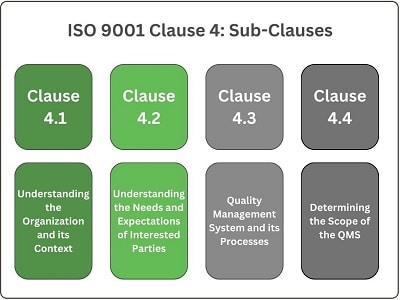ISO 9001:2015 Clause 4
Please Note:
ISO 9001 Climate Change Amendment
Effectively Immediately
On February 23, 2024, a new Amendment to ISO 9001 was published and it impacts all companies that are currently ISO 9001 certified as well as any certifications going forward. Learn More
What is ISO 9001:2015 Clause 4?
Clause 4 of the ISO 9001 standard, titled “Context of the Organization,” serves the purpose of establishing a comprehensive understanding of the organization and its operating environment. The overall purpose of this clause is to provide a foundation for the development and implementation of a quality management system (QMS) that is aligned with the organization’s objectives and meets the needs of interested parties.
Clause 4, Context of the Organization, sets the stage for subsequent clauses in ISO9001 and lays the foundation for the development, implementation, and continual improvement of a robust and effective QMS.
The Specific Objectives of Clause 4, Context of the Organization, are as follows:
Get a Free Quote
4.1 Understanding the Organization and Its Context:
Clause 4.1 requires organizations to identify and document their internal and external context. It involves analyzing factors such as the organization’s mission, values, culture, governance structure, size, complexity, and industry sector. By gaining a holistic understanding of the organization, its purpose, and its unique characteristics, the organization can shape its QMS to suit its specific needs.
4.2 Understanding the Needs and Expectations of Interested Parties:
Clause 4.2 requires that organizations determine the relevant interested parties that can affect or be affected by the QMS. This includes customers, suppliers, employees, regulatory bodies, shareholders, and other stakeholders. Understanding the needs, expectations, and requirements of these interested parties helps the organization align its QMS with its needs and enhance customer satisfaction.
4.3 Determining the Scope of the Quality Management System:
Clause 4.3 requires the organization to establish the boundaries and applicability of its QMS. This involves specifying the products, services, processes, and organizational units covered by the QMS. The scope determines the extent to which the organization’s QMS is implemented and sets the context for subsequent planning and implementation activities.
4.4 Quality Management Systems and Its Processes:
Clause 4.4 requires organizations to identify and evaluate the risks and opportunities that can impact the achievement of the QMS objectives. This involves assessing internal and external factors that may positively or negatively influence the organization’s ability to provide products and services that meet customer requirements. By identifying risks and opportunities, the organization can take appropriate actions to mitigate risks and capitalize on opportunities.

Complying With Clause 4
Complying with Clause 4, titled “Context of the Organization,” in the ISO 9001 Standard involves understanding and addressing the internal and external factors that can affect an organization’s ability to achieve its quality objectives. Here are some examples of how an organization can comply with Clause 4:
1. Identify interested parties: Determine the stakeholders, customers, regulatory bodies, and other interested parties relevant to the organization’s QMS. Understand their needs, expectations, and requirements to ensure alignment with their expectations.
2. Define the scope of the QMS: Clearly define the boundaries and extent of the QMS within the organization. This includes determining the processes, departments, locations, and functions that fall within the scope of the QMS.
3. Determine the internal and external issues: Identify and analyze the internal factors (e.g., organizational culture, resources, capabilities) and external factors (e.g., market trends, legal and regulatory requirements, competition) that can impact the organization’s ability to achieve quality objectives.
4. Identify and assess risks and opportunities: Conduct a thorough risk assessment to identify potential risks and opportunities related to the QMS. This involves considering factors such as operational risks, market risks, technological risks, and regulatory risks. Develop strategies to mitigate or exploit these risks and opportunities.
5. Establish the QMS objectives: Based on the identified internal and external issues, set measurable quality objectives that align with the organization’s strategic goals. These objectives should be specific, measurable, achievable, relevant, and time-bound (SMART).
6. Define the QMS scope and exclusions: Determine any specific exclusions or boundaries within the QMS, clarifying which requirements of ISO 9001 are applicable and which are not, based on the organization’s activities, products, and services.
7. Maintain documentation: Document the organization’s context, interested parties, scope, and identified risks and opportunities. This can be in the form of a documented information management system or specific procedures to ensure the information is accessible and available to relevant personnel.
8. Periodically review the context: Continually monitor and review the organization’s internal and external context to ensure ongoing relevance and alignment with the QMS. This includes staying updated with changes in the business environment, regulatory requirements, and customer expectations.
9. Communicate the context: Ensure effective communication of the organization’s context and its implications to relevant stakeholders, including employees, suppliers, and customers. This helps create awareness and understanding of how the organization operates within its specific context.
10. Update the QMS: If there are changes in the organization’s context, interested parties, or identified risks and opportunities, update the QMS accordingly to ensure its continued effectiveness and alignment with the organization’s goals.
Compliance with Clause 4 demonstrates an organization’s commitment to understanding its operating environment and aligning its QMS with the relevant internal and external factors. By systematically addressing the context of the organization, organizations can enhance their ability to meet customer expectations, manage risks, and drive continual improvement.
The History of Clause 4 of the ISO 9001 Standard
Clause 4 of the ISO 9001 standard has a significant history that spans multiple revisions of the standard. Let’s look at the evolution of Clause 4 throughout the history of ISO 9001:
ISO 9001:1987:
The first version of ISO 9001 was published in 1987, and it did not have a specific clause dedicated to the “Context of the Organization.” The standard primarily focused on quality assurance and control processes within organizations.
ISO 9001:1994:
In the 1994 revision, ISO 9001 introduced the concept of the “Quality System,” which included requirements related to the “Quality Manual” and “Quality Policy.” However, there was no dedicated clause addressing the broader context of the organization.
ISO 9001:2000:
The year 2000 saw a major revision of ISO 9001, aligning it with the new High-Level Structure (HLS) developed by ISO. Clause 4, titled “Quality Management System,” was introduced to address the context of the organization. It emphasized the importance of understanding the organization’s purpose, identifying interested parties, and determining the scope of the QMS.
ISO 9001:2008:
The 2008 revision did not bring significant changes to Clause 4. The requirements remained consistent with the previous version, emphasizing the need for organizations to determine their context, understand customer requirements, and define the scope of the QMS.
ISO 9001:2015:
The most significant change occurred in the 2015 revision of ISO 9001. Clause 4 was completely restructured and expanded to address the broader context in which the organization operates. The revised clause, titled “Context of the Organization,” requires organizations to consider both internal and external factors that can influence their QMS. It emphasizes understanding the organization’s context, interested parties, and requirements to shape the QMS effectively.
ISO 9001:2015 introduced specific sub-clauses under Clause 4, including:
4.1 Understanding the Organization and its Context
4.2 Understanding the Needs and Expectations of interested parties
4.3 Determining the scope of the quality management system
4.4 Quality Management System and its Processes
The current version of ISO 9001, ISO 9001:2015, places significant importance on Clause 4, underscoring the need for organizations to have a deep understanding of their context, interested parties, and scope of their QMS. This context-driven approach helps organizations align their quality management efforts with their strategic objectives, stakeholders’ expectations, and the specific requirements of their industry or sector.
Consulting Support for ISO 9001
Every year, we help hundreds of small businesses achieve ISO 9001 certification. Support for ISO 9001 is available through any of our Consulting Programs
As an American business with a story like yours, we know that time is valuable. Our expert consultants are here to take on the difficult, technical aspects of certification so you can focus on your business. They’ll work with you every step of the way until you’re successfully certified.
Interested? Get a Free Quote.
In many industries, ISO 9001 has become a supply-chain requirement. When landing a big contract, ISO 9001 certification could make all the difference.
About Scott Dawson
Since 2010, Scott Dawson, President of Core Business Solutions, has been an active voting member of the U.S. Technical Advisory Group (TAG) to ISO Technical Committee 176 (TC 176). TAG 176 members meet to discuss and develop U.S. positions for Quality Management standards, including ISO 9001:2015, which will be revised in 2026.

Related Standards
We provide consulting support for various other standards, as well as support for companies seeking multiple certifications through an Integrated Management System.
AS9100
Aerospace Manufacturers
AS9120
Aerospace Distributors
ISO 14001
Environmental Management Systems
ISO 27001
Information Security Management Systems
ISO 20000-1
Service Management Systems
ISO 45001
OH&S Management Systems
ISO 13485
Medical Device Manufacturers
AS9100
AS9120
ISO 14001
ISO
20000-1
ISO 27001
ISO 45001
ISO 13485
Equip Your Business to Meet ISO 9001 With CORE
At Core Business Solutions, we’re here to equip your company for success in meeting ISO 9001 requirements. We’ve helped hundreds of small businesses grow and deliver the best solutions to their clients. We provide ISO training services, consulting help, and compliance software and to help you get certified and stay certified. We focus on optimizing your processes and helping you implement an ISO-compliant QMS. When you partner with us, you’ll get the tools and help you need for success.
For more information on the ISO 9001:2015 standard, please visit our articles page. You can also call our consulting office at 866-354-0300 or contact us online.
Do you want to update your existing ISO 9001 QMS System or refresh it?
We provide consulting services to assist you in your ISO 9001 Quality Management System refresh. We listen, conduct a gap analysis, update your Quality Policy and any necessary documentation or procedures, find areas of waste or improvement, simplify and automate. And we do it fast. Core offers firm, fixed pricing. Download our information sheet today to learn more or call us at 866-354-0300 Extension 2.
